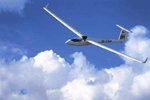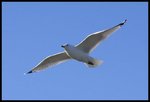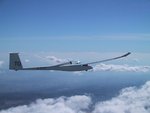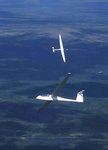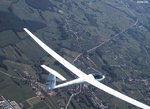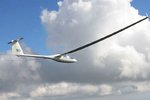Navigation
Install the app
How to install the app on iOS
Follow along with the video below to see how to install our site as a web app on your home screen.
Note: This feature may not be available in some browsers.
More options
You are using an out of date browser. It may not display this or other websites correctly.
You should upgrade or use an alternative browser.
You should upgrade or use an alternative browser.
Glider clip
- Thread starter sunny91
- Start date
Ad: This forum contains affiliate links to products on Amazon and eBay. More information in Terms and rules
More options
Who Replied?Glider
Captain
Many thanks.
Good one sunny.
- Thread starter
- #4
Glider
Captain
Thanks again. The woman in the first clip really knows what she is doing. A slow roll in a glider is a difficult manoever than a powered aircraft as the secondary control effects means that its much more difficult to do than in an aircraft and its a lot more dangerous. I couldn't make out what type of glider that she was in but it was clearly designed for aerobatics and well equipped.
In the second clip in case you are wondering what is making the noise that goes up and down in pitch, its an audio vario that enables you to tell if you are gaining and losing height without looking at the instruments. The higher the pitch the more height you are gaining the lower or when it starts bipping towards the end of the clip then you are losing height. The ideal is to get the pitch high but steady, which means that you have centered on the thermal and the ride is a lot smoother. If you don't then it can be rough as on one side of the turn you can be climbing at 800ft per min, 6-7 seconds later on the other side of the turn it could be 0 - 200ft per min, then 6 - 7 seconds your back to 800ft per min. Do that for a while and its rough.
Its a vitally important instrument as its quite common to have a number of gliders in the same thermal, in close proximity to each other say 50 yards away from each other, all trying to outperform each other by gaining height, it isn't formation flying. So keeping your heads up out of the cockpit is an absolute must, as is trusting the other pilots in the stack.
Apologise to those who knew this but it may be new to some of the people on the forum.
In the second clip in case you are wondering what is making the noise that goes up and down in pitch, its an audio vario that enables you to tell if you are gaining and losing height without looking at the instruments. The higher the pitch the more height you are gaining the lower or when it starts bipping towards the end of the clip then you are losing height. The ideal is to get the pitch high but steady, which means that you have centered on the thermal and the ride is a lot smoother. If you don't then it can be rough as on one side of the turn you can be climbing at 800ft per min, 6-7 seconds later on the other side of the turn it could be 0 - 200ft per min, then 6 - 7 seconds your back to 800ft per min. Do that for a while and its rough.
Its a vitally important instrument as its quite common to have a number of gliders in the same thermal, in close proximity to each other say 50 yards away from each other, all trying to outperform each other by gaining height, it isn't formation flying. So keeping your heads up out of the cockpit is an absolute must, as is trusting the other pilots in the stack.
Apologise to those who knew this but it may be new to some of the people on the forum.
- Thread starter
- #6
- Thread starter
- #7
FLYBOYJ
"THE GREAT GAZOO"
Great clip sunny and great info Glider - I never seen (or heard) and audio vario....
Glider
Captain
FLYBOYJ said:Great clip sunny and great info Glider - I never seen (or heard) and audio vario....
Once you have flown with one you will be loath to fly without one. With the audio vario to give you an indication as to climb, the sound of the air over the wings for speed and the strand of wool on the canopy for turn and slip, you hardly have to look at the instruments at all.
Mine was an older instrument and the one problem was that there was a slight lag between the maximum climb and the highest pitch. So you had to work out where you were pointing when the highest pitch was heard, imagine it a half second earlier, and work out when to ease the turn so you could go back to the stronger part of the thermal.
Modern instruments don't have that delay.
Glider
Captain
Waveflight. The title is to do with the term wave. Its a type of aircurrent that enables you to gain height quickly and go to great heights 20,000 feet is by no means unknown in good conditions and you fly smoothly if (note that if) you can find it and enter it at the right height.
The best way to describe it is to look at a stream of water going through a wood. The water on top is smooth, the water underneath is bouncing along the rocks and stones on the bed of the stream. The same thing happens in the air over mountain ranges and hills. An obvious problem is that you cannot see it. The wind has to be in the correct direction and strength for the range in question, but this does not guarantee that it will be there. One give away is a certain type of cloud.
In the video you will see that they are heading for a saucer type cloud. These indicate the presence of wave and its normally approached from the sun side of the cloud as that is were the thermals are more likely. You will also try to gain as much height as you can before you get there. Remember the comparison with the water in the stream, if you try to join at to low an altitude you will enter the turbulant air below the wave. These are very strong air currents and in the early days when people were discovering this type of lift, it was not unknown for the glider to break up. Even today you will know that you have had a hard day if you get caught up in those currents.
One other feature is the changes that can occur, as you know what goes up must come down, even air. You will see that the pilot was climbing at a steady 6-700ft/min, then it drops to 1-200ft/min and then before you know it he is come off the wave and is losing height at what looked like 600ft/min. Its not boring.
The best way to describe it is to look at a stream of water going through a wood. The water on top is smooth, the water underneath is bouncing along the rocks and stones on the bed of the stream. The same thing happens in the air over mountain ranges and hills. An obvious problem is that you cannot see it. The wind has to be in the correct direction and strength for the range in question, but this does not guarantee that it will be there. One give away is a certain type of cloud.
In the video you will see that they are heading for a saucer type cloud. These indicate the presence of wave and its normally approached from the sun side of the cloud as that is were the thermals are more likely. You will also try to gain as much height as you can before you get there. Remember the comparison with the water in the stream, if you try to join at to low an altitude you will enter the turbulant air below the wave. These are very strong air currents and in the early days when people were discovering this type of lift, it was not unknown for the glider to break up. Even today you will know that you have had a hard day if you get caught up in those currents.
One other feature is the changes that can occur, as you know what goes up must come down, even air. You will see that the pilot was climbing at a steady 6-700ft/min, then it drops to 1-200ft/min and then before you know it he is come off the wave and is losing height at what looked like 600ft/min. Its not boring.
- Thread starter
- #11
Glider
Captain
- Thread starter
- #13
- Thread starter
- #14
- Thread starter
- #15
Users who are viewing this thread
Total: 1 (members: 0, guests: 1)
Similar threads
- Replies
- 9
- Views
- 2K

